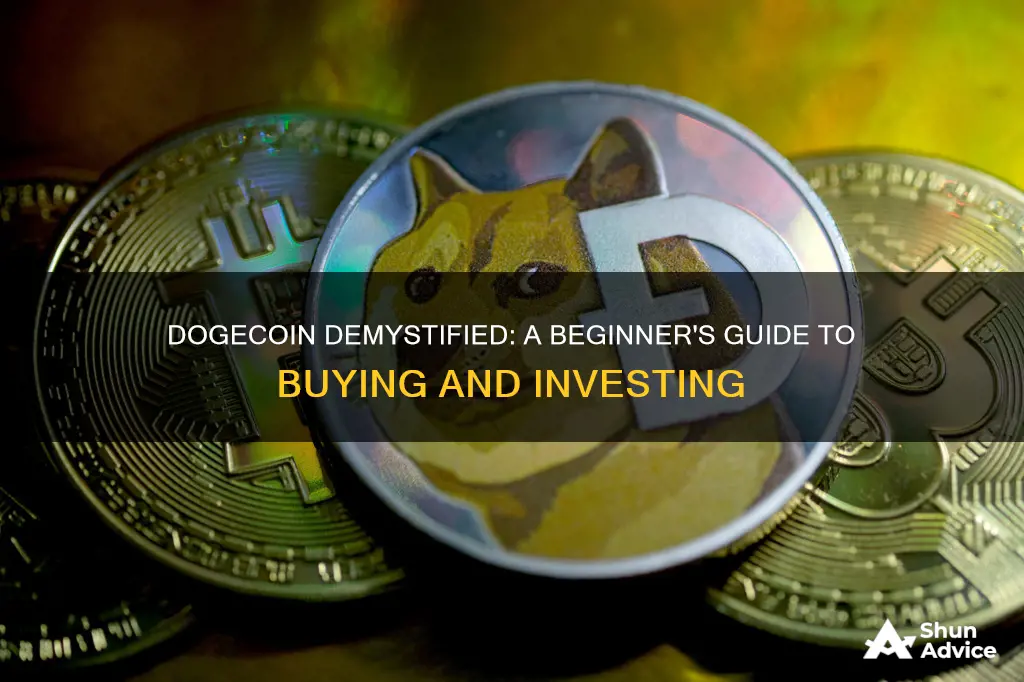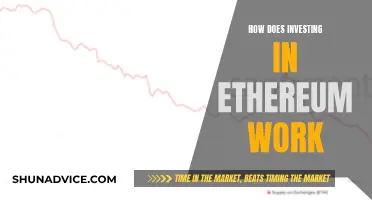
Dogecoin is a decentralised cryptocurrency that was initially created as a joke, parodying Bitcoin and the wild speculation of the crypto market. It has since gained significant attention due to its meme-inspired branding and support from Tesla CEO, Elon Musk. Dogecoin is considered a risky and volatile investment, and investors are encouraged to exercise caution.
To buy Dogecoin, you'll need to open an account with a cryptocurrency exchange, such as Coinbase, Kraken or Binance. You can then deposit funds, either in the form of fiat currency or cryptocurrency, and purchase Dogecoin. It's important to note that Dogecoin is a highly speculative investment, and its value is largely driven by social media movements and hype.
| Characteristics | Values |
|---|---|
| Investment risk | High |
| Volatility | High |
| Affordability | Low |
| Transaction costs | Low |
| Payment methods | Debit/credit card, Google/Apple Pay, third-party payment, wire transfer, PayPal transfer, cash |
| Storage options | Hot wallet, cold wallet, exchange |
| Founders | Billy Markus, Jackson Palmer |
| Launch year | 2013 |
What You'll Learn

How much to invest in Dogecoin
Dogecoin is a highly volatile and risky investment. It is important to consider your overall financial situation, investment portfolio, and risk tolerance before deciding how much to invest.
Risk Factors
Dogecoin is a "meme" cryptocurrency that was created as a joke and has gained attention due to its viral branding and celebrity endorsements. It has no supply cap, and its price is largely driven by social media hype. As a result, Dogecoin's value is prone to extreme fluctuations.
Expert Recommendations
Experts advise against investing more than you are willing to lose when it comes to cryptocurrencies. For risky assets like Dogecoin, it is recommended that they make up no more than 3% to 10% of your investment portfolio.
Factors to Consider
When deciding how much to invest in Dogecoin, consider your current financial situation and risk tolerance. If you are behind on retirement savings or lack an emergency fund, you should invest less. On the other hand, if you are financially stable and on track to meet your financial goals, you may be willing to invest a larger portion of your portfolio in Dogecoin.
Payment Methods
When purchasing Dogecoin, you can use fiat currency or other cryptocurrencies. Exchanges like Binance offer various payment options, including debit/credit cards, Google Pay, Apple Pay, and third-party payment channels.
Remember, investing in Dogecoin is a speculative and risky venture. Only invest what you can afford to lose, and ensure you understand the risks and potential losses before proceeding.
Task Investment: Navigating the World of Task Markets and Finance
You may want to see also

Choosing a cryptocurrency exchange
Reputation and Security
Look for a well-known and reputable exchange that has strong security measures in place. This includes two-factor authentication, cold storage of funds, and regular security audits. The exchange should also have a good track record for security and reliability. Some popular options include Coinbase, Kraken, and Binance. However, it is important to research and compare different exchanges before making a decision.
Fees and Payment Methods
Different exchanges have different fee structures, so it is important to compare fees to find the most cost-effective option. Consider the payment methods accepted by the exchange, such as credit or debit cards, wire transfers, or PayPal transfers. Some exchanges may also allow the purchase of Dogecoin with other cryptocurrencies.
Supported Cryptocurrencies
Ensure that the exchange supports the trading of Dogecoin (DOGE) and any other cryptocurrencies you may be interested in. Check if the exchange allows you to access your own digital wallet, enabling you to send and receive Dogecoin.
User Interface and Functionality
Consider the user-friendliness and functionality of the exchange's platform. Look for an exchange with an intuitive and easy-to-navigate interface, especially if you are a beginner. Some exchanges may also offer additional features such as limit orders or the ability to customize your trading view.
Geographic Availability
Not all exchanges are available in every country or region. Check that the exchange you choose is accessible in your location. Some exchanges may have restrictions or prohibitions for certain countries.
Customer Support
Opt for an exchange that offers reliable customer support to assist you with any issues or queries you may have. This is particularly important if you are new to cryptocurrency trading.
Regulatory Compliance
Consider the regulatory environment in which the exchange operates. While decentralized exchanges offer greater privacy, they may have less regulatory oversight. On the other hand, centralized exchanges are subject to government regulations, but as the FTX collapse showed, this does not always guarantee protection from fraudulent activities.
Australia: Invest Now?
You may want to see also

Payment options
Before you can begin trading cryptocurrencies, you must deposit money into your exchange or brokerage account. The exchanges usually allow you to deposit money from a checking or savings account. Some also accept wire transfers and PayPal transfers. A few exchanges even permit the use of a credit card to buy Dogecoin, but this is generally discouraged due to the associated fees and higher APR.
If you are already a cryptocurrency owner, you can trade some of your existing digital assets for Dogecoin. However, not all cryptocurrencies can be exchanged for Dogecoin, and each platform has different rules about what is allowed.
When using a platform like Binance to buy Dogecoin, you can choose from several payment options. These include:
- Debit/Credit Card
- Google Pay or Apple Pay
- Third-Party Payment Channels
Student Debt vs. Stock Market: Where Should Your Money Go?
You may want to see also

Placing your order
Once you have decided how much you want to invest in Dogecoin, selected a cryptocurrency exchange, and deposited money into your account, you can place your order.
On the exchange's trading or purchase platform, search for Dogecoin or enter its ticker symbol, DOGE. Then, choose your trade type and input either the dollar amount you want to invest or the number of Dogecoins you want to buy.
Dogecoin can be purchased with debit or credit cards, Google Pay or Apple Pay, or via third-party payment channels.
If you already own cryptocurrency, you may be able to trade some of your existing digital assets for Dogecoin. However, not all cryptocurrencies can be exchanged for Dogecoin, and each platform has different rules.
Once you have placed your order, it should go through immediately. Dogecoin can be traded 24 hours a day, seven days a week.
After making the purchase, you can transfer your Dogecoin to your other wallets.
Retirement Investing: Navigating the Cautionary Tales
You may want to see also

Storage options
When you buy Dogecoin, it is, by default, kept in your exchange's or brokerage's crypto wallet. However, because these wallets are generally connected to the internet, some investors prefer to withdraw their crypto and store it in another wallet.
You can choose to store your Dogecoin in a hot wallet or a cold wallet outside of your exchange. Hot wallets are digital and connected to the internet, whereas cold wallets are physical hardware that you can disconnect, making them much less susceptible to hacking.
Hot Wallets
Hot wallets are a convenient option for those who want to access their Dogecoin on the go. They are usually free and can be installed on your computer or smartphone. Examples of hot wallets include the Exodus Wallet, Coinomi Wallet, and Trust Wallet. While hot wallets are vulnerable to hacking, there are ways to bolster their security, such as using strong and unique passwords, enabling two-factor authentication, and regularly updating the wallet's software.
Cold Wallets
Cold wallets are a more secure option for storing Dogecoin, as they are not connected to the internet. They are physical devices that store your private keys offline, adding an extra layer of security. Examples of cold wallets include the Ledger Nano S, Trezor One, and Dogecoin Paper Wallet. While cold wallets are generally more expensive than hot wallets, they offer greater protection against cyber threats. However, it is important to note that you run a greater risk of being unable to access your cryptocurrency if you lose or forget the password necessary to get into your cold wallet.
Hospitals: A Healthy Investment
You may want to see also
Frequently asked questions
Dogecoin (DOGE) is a decentralised cryptocurrency that was created as a parody of Bitcoin. It was founded by software engineers Billy Markus and Jackson Palmer and launched in 2013. Dogecoin is similar to Bitcoin in that it is a digital currency that can be used for peer-to-peer transactions.
You can buy Dogecoin on a cryptocurrency exchange, such as Coinbase, Kraken, Binance or Robinhood. You'll need to create an account, verify your identity and deposit funds. Then, search for Dogecoin (DOGE) on the exchange, check its market price and make a purchase.
Dogecoin is a risky and highly volatile investment. It has no supply cap, which means that for Dogecoin's price to increase or even remain steady, investors have to continually buy more coins. This makes Dogecoin uniquely volatile when compared with other cryptocurrencies like Bitcoin.
You can store your Dogecoin in a "hot wallet" or a "cold wallet". Hot wallets are digital and connected to the internet, making them more susceptible to hacking. Cold wallets are physical hardware that you can disconnect from the internet, making them less vulnerable to hacking.
Investing in Dogecoin may be fun and could potentially bring vigorous short-term value. However, Dogecoin has no intrinsic value and is not a long-term investment asset. There is a real risk of losing all your money, and Dogecoin is not taken seriously by experienced investors.







